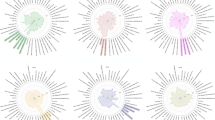Abstract
Background
Skeletal class III malocclusion has a diverse and complicated aetiology involving environmental and genetic factors. It is critical to correctly classify and define this malocclusion to be diagnosed and treated on a clinically sound basis. Thus, this study aimed to provide reliable and detailed measurements in a large ethnically homogeneous sample of Chinese adults to generate an adequate phenotypic clustering model to identify and describe the skeletal variation present in skeletal class III malocclusion.
Materials and methods
This is a retrospective cross-sectional study in which 500 pre-treatments cone-beam computed tomography (CBCT) scans of patients with skeletal class III malocclusion (250 males and 250 females) were selected following specific selection criteria. Seventy-six linear, angular, and ratios measurements were three-dimensionally analysed using InVivo 6.0.3 software. These measurements were categorised into 47 skeletal, 18 dentoalveolar, and 11 soft tissue variables. Multivariate reduction methods: principal component analyses and cluster analyses were used to present the most common phenotypic groupings of skeletal class III malocclusion in Han ethnic group of Chinese adults.
Results
The principal component analysis revealed eight principal components accounted for 72.9% of the overall variation of the data produced from the seventy-six variables. The first four principal components accounted for 53.37% of the total variations. They explained the most variation in data and consisted mainly of anteroposterior and vertical skeletal relationships. The cluster analysis identified four phenotypes of skeletal class III malocclusion: C1, 34%; C2, 11.4%; C3, 26.4%; and C4, 28.2%.
Conclusion
Based on three-dimensional analyses, four skeletal class III malocclusion distinct phenotypic variations were defined in a large sample of the adult Chinese population, showing the occurrence of phenotypic variation between identified clusters in the same ethnic group. These findings might serve as a foundation for accurate diagnosis and treatment planning of each cluster and future genetic studies to determine the causative gene(s) of each cluster.




Similar content being viewed by others
Data availability
All datasets analysed during the current study are not publicly available due to the confidentiality of the data extracted, but it will be available upon direct request from the corresponding author.
Abbreviations
- CBCT:
-
Cone-beam computed tomography
- 3D:
-
Three-dimensional
- PCA:
-
Principal component analysis
- PCs:
-
Principal components
- CA:
-
Cluster analysis
- ICC:
-
Intra-class correlation coefficient
- rTEM and TEM:
-
Relative and absolute technical error of the measurements
References
Staudt CB, Kiliaridis S (2009) Different skeletal types underlying class III malocclusion in a random population. Am J Orthod Dentofac Orthop 136:715–721. https://doi.org/10.1016/j.ajodo.2007.10.061
Alhammadi MS, Fayed MS, Labib A (2016) Three-dimensional assessment of temporomandibular joints in skeletal class I, class II, and class III malocclusions: cone beam computed tomography analysis. J World Fed Orthod 5:80–86. https://doi.org/10.1016/j.ejwf.2016.07.001
Alhammadi MS, Shafey AS, Fayed MS, Mostafa YA (2014) Temporomandibular joint measurements in normal occlusion: a three-dimensional cone beam computed tomography analysis. J World Fed Orthod 3:155–162. https://doi.org/10.1016/j.ejwf.2014.08.005
Jaradat M (2018) An overview of class III malocclusion (prevalence, etiology and management). J Adv Med Med Res 1–13. https://doi.org/10.9734/JAMMR/2018/39927
Doraczynska-Kowalik A, Nelke KH, Pawlak W, Sasiadek MM, Gerber H (2017) Genetic factors involved in mandibular prognathism. J Craniofac Surg 28:e422–e431. https://doi.org/10.1097/SCS.0000000000003627
Dehesa-Santos A, Iber-Diaz P, Iglesias-Linares A (2021) Genetic factors contributing to skeletal class III malocclusion: a systematic review and meta-analysis. Clin Oral Investig 25:1587–1612. https://doi.org/10.1007/s00784-020-03731-5
Lew K, Foong W (1993) Horizontal skeletal typing in an ethnic Chinese population with true class III malocclusions. Br J Orthod 20:19–23. https://doi.org/10.1179/bjo.20.1.19
Xue F, Wong R, Rabie A (2010) Genes, genetics, and class III malocclusion. Orthod Craniofac Res 13:69–74. https://doi.org/10.1111/j.1601-6343.2010.01485.x
Alsufyani NA, Hess A, Noga M, Ray N, Al-Saleh MA, Lagravère MO, Major PW (2016) New algorithm for semiautomatic segmentation of nasal cavity and pharyngeal airway in comparison with manual segmentation using cone-beam computed tomography. Am J Orthod 150:703–712. https://doi.org/10.1016/j.ajodo.2016.06.024
Aksoy S, Kelahmet U, Hincal E, Oz U, Orhan K (2016) Comparison of linear and angular measurements in CBCT scans using 2D and 3D rendering software. J Biotechnol Biotec Eq 30:777–84. https://doi.org/10.1259/dmfr/15644321
Abu Alhaija ES, Richardson A (2003) Growth prediction in class III patients using cluster and discriminant function analysis. Eur J Orthod 25:599–608. https://doi.org/10.1093/ejo/25.6.599
Bui C, King T, Proffit W, Frazier-Bowers S (2006) Phenotypic characterization of class III patients: a necessary background for genetic analysis. Angle Orthod 76:564–569. https://doi.org/10.1043/0003-3219(2006)076[0564:PCOCIP]2.0.CO;2
de Frutos-Valle L, Martin C, Alarcon JA, Palma-Fernandez JC, Iglesias-Linares A (2019) Subclustering in skeletal class III phenotypes of different ethnic origins: a systematic review. J Evid Based Dent Pract 19:34–52. https://doi.org/10.1016/j.jebdp.2018.09.002
Moreno Uribe LM, Vela KC, Kummet C, Dawson DV, Southard TE (2013) Phenotypic diversity in white adults with moderate to severe class III malocclusion. Am J Orthod Dentofac Orthop 144:32–42. https://doi.org/10.1016/j.ajodo.2013.02.019
Li C, Cai Y, Chen S, Chen F (2016) Classification and characterization of class III malocclusion in Chinese individuals. Head Face Med 12:31. https://doi.org/10.1186/s13005-016-0127-8
Auconi P, Scazzocchio M, Cozza P, McNamara JA Jr, Franchi L (2015) Prediction of class III treatment outcomes through orthodontic data mining. Eur J Orthod 37:257–267. https://doi.org/10.1093/ejo/cju038
Auconi P, Scazzocchio M, Defraia E, McNamara JA, Franchi L (2014) Forecasting craniofacial growth in individuals with class III malocclusion by computational modelling. Eur J Orthod 36:207–216. https://doi.org/10.1093/ejo/cjt036
Li S, Xu TM (2009) and Lin JX [Analysis of treatment templates of Angle’s class III malocclusion patients]. Hua Xi Kou Qiang Yi Xue Za Zhi 27:637–641
Hong SX, Yi CK (2001) A classification and characterization of skeletal class III malocclusion on etio-pathogenic basis. Int J Oral Maxillofac Surg 30:264–271. https://doi.org/10.1054/ijom.2001.0088
de Frutos-Valle L, Martin C, Alarcon JA, Palma-Fernandez JC, Ortega R, Iglesias-Linares A (2020) Sub-clustering in skeletal class III malocclusion phenotypes via principal component analysis in a southern European population. Sci Rep 10:17882. https://doi.org/10.1038/s41598-020-74488-w
Almaqrami B-S, Alhammadi M-S, Cao B (2018) Three dimensional reliability analyses of currently used methods for assessment of sagittal jaw discrepancy. J Clin Exp Dent 10:e352. https://doi.org/10.4317/jced.54578
Kim JY, Lee SJ, Kim TW, Nahm DS, Chang YI (2005) Classification of the skeletal variation in normal occlusion. Angle Orthod 75:311–319. https://doi.org/10.1043/0003-3219(2005)75[311:COTSVI]2.0.CO;2
Barbosa M, Vieira EP, Quintao CC, Normando D (2016) Facial biometry of Amazon indigenous people of the Xingu River - perspectives on genetic and environmental contributions to variation in human facial morphology. Orthod Craniofac Res 19:169–179. https://doi.org/10.1111/ocr.12125
Oh E, Ahn SJ, Sonnesen L (2018) Ethnic differences in craniofacial and upper spine morphology in children with skeletal class II malocclusion. Angle Orthod 88:283–291. https://doi.org/10.2319/083017-584.1
Al Ayoubi A, Khandan Dezfully A, Madléna M (2020) Dentoskeletal and tooth-size differences between Syrian and Hungarian adolescents with class II division 1 malocclusion: a retrospective study. BMC 13:1–7. https://doi.org/10.1186/s13104-020-05115-0
Al Ayoubi A, Dalla Torre D, Madléna M (2020) Craniofacial characteristics of Syrian adolescents with class II division 1 malocclusion: a retrospective study. PeerJ. 8:e9545. https://doi.org/10.7717/peerj.9545
Bastir M, Godoy P, Rosas A (2011) Common features of sexual dimorphism in the cranial airways of different human populations. Am J Phys Anthropol 146:414–22
Gu Y, McNamara JA Jr, Sigler LM, Baccetti T (2011) Comparison of craniofacial characteristics of typical Chinese and Caucasian young adults. Eur J Orthod 33:205–211. https://doi.org/10.1093/ejo/cjq054
Wei SH (1969) Craniofacial variations, sex differences and the nature of prognathism in Chinese subjects. Angle Orthod 39:303–315. https://doi.org/10.1043/0003-3219(1969)039<0303:CVSDAT>2.0.CO;2
Yeong P, Huggare J (2004) Morphology of Singapore Chinese. Eur J Orthod 26:605–612. https://doi.org/10.1093/ejo/26.6.605
Funding
This work was supported by the project of the National Natural Science Foundation of Gansu Province, China (No. 20JR5RA264).
Author information
Authors and Affiliations
Contributions
L.H.A collected, analysed, interpreted the data, contributed to the drafting of the article, and critical revision of the article, M.M.A carried out the statistical analyses and interpretation of the data; M.S.A and M.A.A substantially contributed to conception and design of the work and critical revision of the manuscript for important intellectual content; B.A and A.A.A contributed to grammatical and critically commented on the article; and X.L.A contributed to critical revision of the article, supervision, and funding acquisition. All authors read and approved the final manuscript.
Corresponding author
Ethics declarations
Ethics approval and consent to participate
The ethical committee of clinical scientific research of the school of stomatology of Lanzhou University approved this study (No.: LZUKQ-2019–043). Moreover, all patients agreed to the use of their data and signed an informed consent form.
Consent for publication
Not applicable.
Competing interests
The authors declare no competing interests.
Additional information
Publisher's note
Springer Nature remains neutral with regard to jurisdictional claims in published maps and institutional affiliations.
Supplementary Information
Below is the link to the electronic supplementary material.
Rights and permissions
Springer Nature or its licensor (e.g. a society or other partner) holds exclusive rights to this article under a publishing agreement with the author(s) or other rightsholder(s); author self-archiving of the accepted manuscript version of this article is solely governed by the terms of such publishing agreement and applicable law.
About this article
Cite this article
Alshoaibi, L.H., Alareqi, M.M., Al-Somairi, M.A.A. et al. Three-dimensional phenotype characteristics of skeletal class III malocclusion in adult Chinese: a principal component analysis–based cluster analysis. Clin Oral Invest 27, 4173–4189 (2023). https://doi.org/10.1007/s00784-023-05033-y
Received:
Accepted:
Published:
Issue Date:
DOI: https://doi.org/10.1007/s00784-023-05033-y




